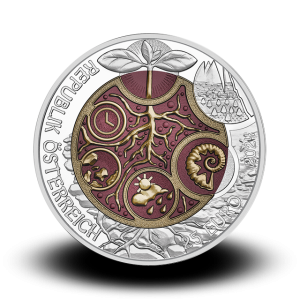16,5 g, (Ag/Nb), Edaphon, The Living Soil, Niobium Coin, 2023
Beneath our feet is an ecosystem on which we depend but are barely even aware of. As diverse as a rainforest, the edaphon,a collective term that encompasses all living organisms present in soil, is a meaningful chaos built by living creatures that results in growth and gives rise to new life.
New
| Mint | Austrian Mint | ||
| Strike year | 2024 | ||
| Purity | 900 / 1000 | ||
| Coin diameter | 34,0 mm | ||
| Face value | 25 EUR | ||
| Silver/niobium mass | 9 g / 6,5 g | ||
| Mass | 16,5 g | ||
| Mintage | 65.000 |
Although soil teems with ants, beetles and earthworms, the human eye does not see the inconspicuous army of microorganisms that lies within. Of vital importance to us, they decompose withered plants and dead trees, creating fertile humus. Working unconsciously together, bacteria, fungi, plants and animals build an intricate structure, but it can break down quickly when farmed. Indeed, although humans have been cultivating the soil for thousands of years, in modern times industrialization has had destructive consequences, with pollution, artificial fertilisers, monocultures and soil compaction reducing or preventing the productivity of the edaphon.
The obverse of Edaphon shows the five factors that contribute to the development of soil: time, mineral material, climate, soil organisms (in the niobium core) and the relief of the landscape (in the outer silver ring). In the centre are the roots of a plant, its leaves protruding into the silver ring. The coin’s reverse features a mole at the top, an earthworm on the left, a snail at the bottom and an ant on the right. The niobium core shows a leaf on top and three other important organisms below: a fungal mycelium on the left, a beetle on the right and an earthworm above it.
| Delivery | On stock |
| Tax | Price including VAT. |
| Preservation | PP: Proof coin struck using a special, high-quality minting process, and made especially for collectors. Modern proof coins often have mirror-like fields and frosted devices. |
| Mint | Austrian Mint |





